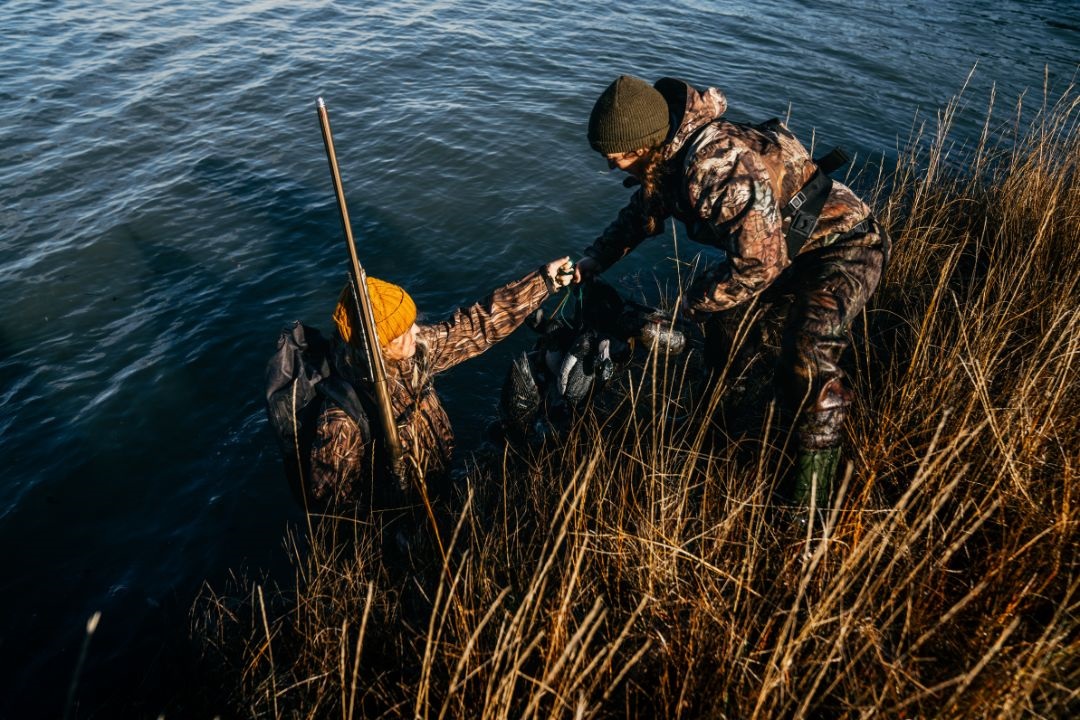Migratory Bird Hunting: Basic Tips for Planning Your Next Hunting Trip
Hunting | March 24, 2024
SAIL
October 13, 2023

It’s no secret that the vast territory of the Côte-Nord offers a wealth of opportunities for hunters and anglers who like doing things on their own. The region’s backcountry, which consists mainly of public land, obviously has great appeal, but for waterfowl hunters, it is the littoral that offers the best promise of perfect duck-hunting action.
Few people are willing to drive for hours along Route 138 to access the vast public land in the backcountry. And yet, every year, some motivated waterfowlers answer the call of adventure and head for the Côte-Nord littoral with hopes of finding abundance.
This article was written in collaboration with Hooké.
In this article, you will learn more about duck hunting on the Côte-Nord:
With very limited agricultural land on the Côte-Nord, it is the water that offers the best opportunities for duck hunting. Common eider, three scoter species and American black duck are the predominant species in the coastal area. The St. Lawrence River is also home to various migratory birds, including the common mallard and green-winged teal.
In the Côte-Nord region, the hunting season for these five species runs every year from mid-September to the end of December. There is a quota of 6 ducks (all species combined) per day per hunter, with a maximum of 18 in possession at all times. Like everywhere else, Barrow’s goldeneye and blue-winged teal harvest is limited to one bird per hunter per day and is only permitted during a specific part of the season. The harvest of harlequin ducks, on the other hand, is prohibited. Unlike some districts further south, it is permitted everywhere on the Côte-Nord to harvest up to 6 black ducks per day. The region is indeed divided into two hunting districts, districts E and B, where the daily bag limit of two ducks doesn’t apply. All in all, the duck hunting regulations in the area are pretty straightforward.
However, it’s important to check the regulations summary, the equipment recommandation before you leave and to always clearly identify the ducks you’re targeting.
One of the most accessible techniques for hunting sea ducks is to set up on a tideland and place 60 to 70-foot decoys upwind (the wind must be blowing in the direction of the decoys). If you’re well camouflaged on a headland near a feeding area, it’s perfectly reasonable to hope for a successful hunt. Thorough exploration to find feeding birds and favourable offshore winds are the keys to success. Hunting early and late in the day when the tide is rising is often a great way to maximize your chances when using this approach.
This makes for greater adaptability to changing conditions and allows for optimal positioning. The positioning in relation to decoys, wind and feeding areas is similar in both cases, but using a motorized boat makes it much easier to access prime hunting spots. There’s no need to have a boat specifically designed for hunting, but it is essential to camouflage it with geotextile fabric, and a low profile is definitely worth considering. It should also be noted that shooting from a boat with the motor running is prohibited.
To hunt migratory birds in Quebec, you need to have both a provincial small game hunting licence and a federal migratory game bird hunting permit. The small game hunting licence is available at SAIL, but the federal migratory bird hunting permit can only be purchased at a Canada Post office. Both are now readily available online as well.
A 12-gauge pump-action or semi-automatic shotgun is the most versatile tool for hunting sea ducks. Since the use of lead shot ammunition is banned for waterfowl, steel shot is the alternative of choice for most enthusiasts. Ducks are relatively large birds, so you’ll want to work with 3- to 3.5-inch bullets with a load of at least 1¼ oz. Shot sizes from #2 to BB are ideal.
The goal here is to maximize long-distance visibility and present a variety of appropriate decoys. Black duck decoys are usually the easiest to find. At least 12 are needed to have a significant impact, and a display of 36 to 48 decoys is ideal. Using motion decoys to add movement can also be a great advantage.
Game calls are a great way to make your overall hunting setup seem more realistic. Plus, the long drives along Route 138 are an ideal time to perfect your calls!
Waterproof clothing is a must; waist-high waders are practically indispensable as well, and you should focus on colours and patterns that blend in well with the environment. You’ll also want to wear wool or fleece linings and breathable underwear, as the best times of the day for hunting are often the coldest. Wearing a high-visibility bib is not required for waterfowl hunting.
As with any harvesting activity, success depends on many criteria that do not depend solely on the hunter. It would take several books to cover everything there is to know about sea duck hunting, and that probably wouldn’t even be enough. One thing’s for sure, though: the Côte-Nord offers plenty of opportunities to come face-to-face with some amazing birds in a magnificent wilderness setting. The region is an accessible place for learning, where adventure and discovery combine to create lasting memories.